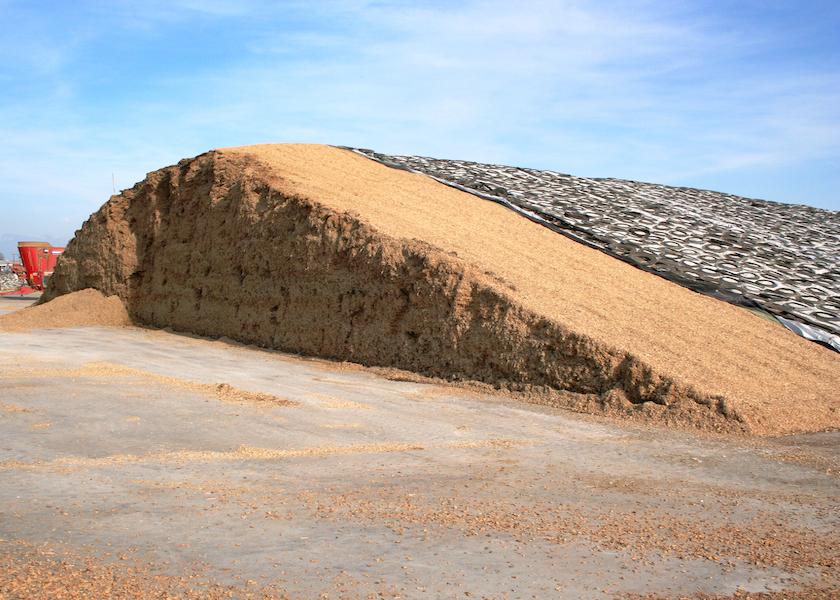Drones Hone in on Silage Inventories

A high-tech inventory assessment program developed for the stone aggregate business is now being used to help dairies assess forage inventories.
Just like quarries, most large dairies have massive stockpiles of resources in inventory, but in the form of silage piles and bunkers versus sand and gravel. Harrison Hobart, On-Farm Specialist for Alltech, Inc., uses the same drone-driven computer model as quarries to serve his customers to accurately measure how much silage they have on hand.
Hobart has an animal science and nutrition background, but also is a licensed drone operator. He shared with the audience of a recent “Technology Dairy Tuesday” webinar from the Cornell PRO-DAIRY program that he has helped manage Alltech’s Aerial Inventory Program for about two years.
He said the inventory assessment program uses cloud-based software that can be accessed via cellphone or computer, and interfaced with his drone. A cellphone app is linked to the controller that runs the drone on the farm. The program uses “photogrammetry” – using images for measuring – to assess volume of inventory.
Viewing a silage pile from many different angles, combined with GPS data on each individual picture, allows him to “stitch” hundreds of pictures together to create a 3-D model.
“The software provider says system can perform volume calculations at an accuracy rate within 1-2% compared to ground-based laser measurements,” shared Hobart.
While the actual volume measurement is very precise, silage does not have consistent moisture content or packing density. That’s where potential for variation occurs, requiring additional data to ultimately calculate actual tonnage.
Hobart adopts a mantra of, “don’t guess – test,” when it comes to this step. He said book values for density and dry matter can vary significantly among individual farms and silage crops. That’s why he takes multiple core samples – whenever it is safe to do so – from at least 5-6 locations across a silage face to measure density and dry matter.
“I’ve measured average densities over the past two years in corn silage drive-over piles as low as 12 pounds of dry matter per cubic foot and as high as 24,” he stated. “If I had put an average density of 16 on either one of those piles, my tonnage estimate would have been off by quite a bit.”
He evaluates each core sample for weight and dry matter, noting the accuracy advantage of handling those samples individually. “I’ve especially noticed that in haylage piles where we have several cuttings piled on each other, those dry matters can vary considerably,” said Hobart. “I’ve seen a 15-foot-wide by 10-foot-tall pile with four cuttings all stacked together, and dry matters ranging from 25 to 55%.”
Hobart said drive-over piles are ideal for the drone-based volume estimation, while closed-end bunkers, overhangs, sloping dirt walls, and overlapping piles require him to make manual adjustments in the program to improve volume accuracy. Then, armed with volume, density, and dry-matter data, he is able to generate customer reports on dry matter and as-fed tons for each pile or bunker.
As a rule, Hobart advises customers the reports should be accurate within about two weeks of feed out. Again, assessment of piles typically will be more precise than bunkers. In some cases, his pile estimates have been dialed in as close as within a day of feed out.
In addition to helping customers know how much feed they have available and how long it should last, Hobart is able to help farms determine feed loss due to fermentation and shrink by taking a baseline reading of the fresh pile or bunker, measuring it again after it has been fed out for several weeks, and comparing the difference to the farm’s feed-out records.
Hobart said the data is also valuable from a farm accounting perspective. Customers routinely share the information with their bankers to assess the value of feed on hand as part of their net worth statements, and some have used it for forage sales and farm ownership transitions.
One thing Hobart has not done with the technology – but would like to – is to evaluate a fresh pile or bunker at harvest and again several weeks later, before any of it is fed. Industry estimates indicate that up to 10% of silage volume is lost strictly to fermentation. “It would be interesting to evaluate the loss purely from fermentation, and it would be very easy to do,” said Hobart.
For more on dairy technology, read:
- Technology Helps Vermont Family Meet Herd and Family Goals
- Cows Need Certain Personalities to Handle Robots
- Can We Use Technology to Screen for Sick Calves?







